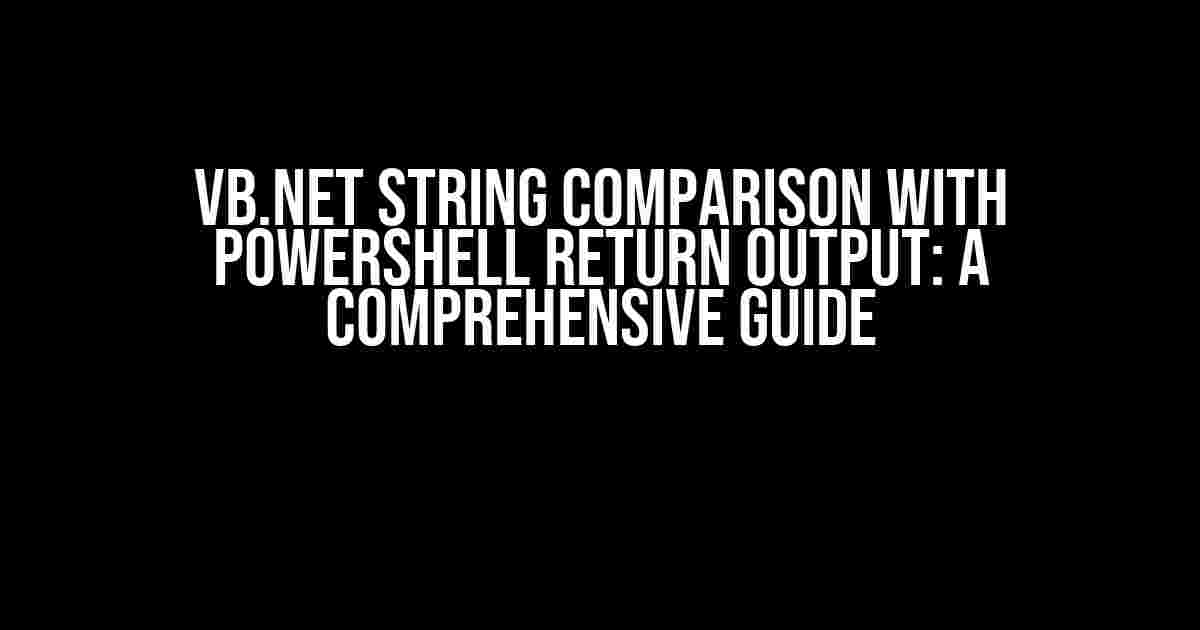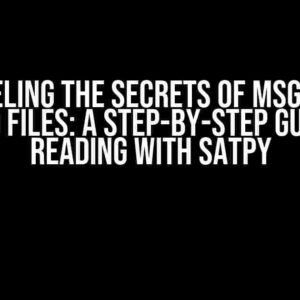Are you tired of sifting through complex code and confusing tutorials to learn how to compare strings in VB.net and integrate it with Powershell return output? Look no further! In this article, we’ll take you on a step-by-step journey to master the art of string comparison in VB.net and seamlessly integrate it with Powershell return output. Buckle up, because we’re about to dive into the world of coding!
Understanding VB.net String Comparison
In VB.net, string comparison is a crucial aspect of programming. It allows you to compare two or more strings to determine if they are equal, not equal, or if one string is greater than or lesser than another. But before we dive into the nitty-gritty, let’s quickly review the basics of string comparison in VB.net.
The Basics of String Comparison in VB.net
String.Equals(): This method compares two strings and returns a boolean value indicating if they are equal.String.Compare(): This method compares two strings and returns an integer value indicating if they are equal, not equal, or if one string is greater than or lesser than another.String.Contains(): This method checks if a string contains a specified substring and returns a boolean value.
Ah, but that’s not all! There are more advanced string comparison methods in VB.net, which we’ll cover later. First, let’s set the stage for our powershell integration.
Understanding Powershell Return Output
Powershell is a powerful task automation and configuration management framework from Microsoft. It’s widely used for scripting and automation tasks. In our case, we’ll use Powershell to generate output that we’ll then compare with our VB.net strings.
Basic Powershell Commands
Before we dive into the integration, let’s quickly review some basic Powershell commands:
# Get the current date and time
Get-Date
# Get the list of files in the current directory
Get-ChildItem
# Get the output of a command as a string
$output = Get-Content -Path "C:\example.txt"
These basic commands will help us generate output that we’ll then compare with our VB.net strings.
Integrating VB.net with Powershell Return Output
Now that we’ve set the stage, it’s time to integrate our VB.net string comparison with Powershell return output. We’ll use the Process class in VB.net to execute our Powershell script and capture its output.
Step 1: Create a New VB.net Project
Create a new VB.net console application project in Visual Studio.
Imports System
Imports System.Diagnostics
Module Module1
Sub Main()
' Our code will go here
End Sub
End Module
Step 2: Create a Powershell Script
Create a new Powershell script that generates output that we’ll compare with our VB.net strings. For example:
# Get the current date and time
Get-Date
Save this script as a file named “script.ps1” in a directory of your choice.
Step 3: Execute the Powershell Script from VB.net
In our VB.net project, we’ll use the Process class to execute our Powershell script and capture its output. Here’s the code:
Imports System
Imports System.Diagnostics
Module Module1
Sub Main()
Dim proceso As New Process()
proceso.StartInfo.FileName = "powershell.exe"
proceso.StartInfo.Arguments = $"-File ""C:\Path\To\script.ps1"""
proceso.StartInfo.UseShellExecute = False
proceso.StartInfo.RedirectStandardOutput = True
proceso.Start()
Dim output As String = proceso.StandardOutput.ReadToEnd()
proceso.WaitForExit()
Console.WriteLine(output)
End Sub
End Module
This code executes our Powershell script and captures its output as a string.
Step 4: Compare the Powershell Output with VB.net Strings
Now that we have the Powershell output as a string, we can compare it with our VB.net strings using the string comparison methods we discussed earlier. For example:
Dim vbString As String = "2022-07-25 14:30:00"
If String.Equals(output, vbString) Then
Console.WriteLine("The strings are equal!")
Else
Console.WriteLine("The strings are not equal!")
End If
This code compares the Powershell output with a VB.net string and prints a message depending on whether they are equal or not.
Advanced String Comparison in VB.net
While the basic string comparison methods are useful, there are more advanced methods that allow for more sophisticated comparisons. Here are a few examples:
String.OrdinalIgnoreCase
This method compares two strings ignoring case:
If String.Equals(output, vbString, StringComparison.OrdinalIgnoreCase) Then
Console.WriteLine("The strings are equal (ignoring case)!")
End If
String.Contains()
This method checks if a string contains a specified substring:
If output.Contains("2022") Then
Console.WriteLine("The string contains the year 2022!")
End If
Regex Matching
Regular expressions (regex) allow for powerful pattern matching in strings. Here’s an example:
Imports System.Text.RegularExpressions
...
Dim regex As New Regex("\b2022\b")
If regex.IsMatch(output) Then
Console.WriteLine("The string contains the year 2022 (regex)!")
End If
These advanced string comparison methods can be used to create complex logic and rules for comparing strings in your VB.net application.
Conclusion
In this article, we’ve covered the basics of string comparison in VB.net, Powershell return output, and how to integrate them to create a powerful and flexible solution. We’ve also explored advanced string comparison methods and techniques to help you master the art of string comparison in VB.net. With this knowledge, you’ll be able to create sophisticated applications that can compare and process strings with ease. Happy coding!
| Method | Description |
|---|---|
String.Equals() |
Compares two strings and returns a boolean value indicating if they are equal. |
String.Compare() |
Compares two strings and returns an integer value indicating if they are equal, not equal, or if one string is greater than or lesser than another. |
String.Contains() |
Checks if a string contains a specified substring and returns a boolean value. |
Remember to bookmark this article and come back to it whenever you need a refresher on VB.net string comparison with Powershell return output. Happy learning!
Frequently Asked Question
Are you stuck with VB.net string comparison with Powershell return output? Worry not, we’ve got you covered! Check out these frequently asked questions to get the answers you need.
Q1: How do I compare a string in VB.net with the output of a Powershell command?
You can use the `Process.Start` method to execute the Powershell command and capture its output as a string. Then, use the `String.Equals` method to compare the output with your desired string. For example: `If myString.Equals(output, StringComparison.OrdinalIgnoreCase) Then …`
Q2: Why does my comparison return False even when the strings appear to be identical?
This could be due to differences in casing or whitespace. Try using the `String.Equals` method with the `StringComparison.OrdinalIgnoreCase` parameter to perform a case-insensitive comparison. You can also use the `Trim` method to remove any leading or trailing whitespace from the output string.
Q3: Can I use the `Like` operator in VB.net to compare a string with a pattern?
Yes, you can use the `Like` operator in VB.net to compare a string with a pattern. For example: `If myString Like “pattern*” Then …`. However, this operator is not as powerful as regular expressions, and may not be suitable for complex pattern matching.
Q4: How do I handle errors when executing a Powershell command from VB.net?
You can use a `Try…Catch` block to catch any exceptions that occur when executing the Powershell command. You can also use the `Process.StandardError` property to capture any error output from the command, and handle it accordingly.
Q5: Can I use regular expressions to compare a string with a pattern in VB.net?
Yes, you can use regular expressions in VB.net to compare a string with a pattern. You can use the `System.Text.RegularExpressions` namespace to create a regular expression pattern and match it against the output string. For example: `If Regex.IsMatch(output, “pattern”) Then …`.




